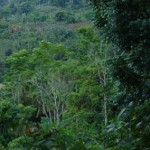
Forest in South America
There are three interesting trends in the United States of America, that have synergistic potential to do something great for this country…reforestation. At first glance, these trends may seem alarming and forebode the worst for our future, but when we look at them in conjunction with one another, they present opportunities. These opportunities would not have been logistically feasible if it were not for the existence of the problems themselves. The first trend is that costs of fuel and other basic products are increasing without a tremendous increase in the average wages of wage laborers when inflation is taken into account. It doesn’t really matter if this trend is a manufactured trend, or if it is a real transition based on previously establish social and economic systems. The effect of this trend has very real results.
When the costs of fuel goes up, and if purchasing power stays the same or gets worse, then mobility decreases. This makes it so people need to make serious decisions on where they work, where they play, and how far they are willing to travel to get there. So the second trend is that people are starting to move closer to the cities. Sometimes people consider moving directly into cities that may have seemed less than ideal in previous decades.
The reason for this influx into the cities is because it makes zero sense to spend twenty dollars a day in fuel just to get to work, if you only make 100 dollars a day. That means you spent one-fifth of your time at work just to pay for your gasoline. It is ridiculous at best.
But with the influx of jobs and people moving into urban areas, there is often an increase in demand for fresh fruits and vegetables. Even though not all city dwellers can usually afford to pay for higher quality food-stuffs, many of the executives and self-employed individuals are willing to pay top dollar for their food. This is especially true in areas where people are health and/or physical appearance conscious.
So the first trend was the increase of fuel prices and the stagnation of wage laborers’ wages, and the second was the movement into cities and demand for high quality vegetables and fruits. But the third trend is not quite as apparent, but nonetheless very real. It is an increase in the public discourse on the concept of Vertical Farms.
Quite simply, a big farm in a skyscraper in or near a city will require less fuel to transport the foodstuffs into that city.
Right now, many of the fruits and vegetables that are in the grocery store may travel between 50 and 1,000 miles or more to get there. It is a highly fuel-inefficient process that may not hold up under the increased stresses on fossil fuel prices.
But if the United States of America became more food independent on a city level, then what would happen to the huge horizontal farms in the center of the country?
There is a tremendous amount of debate on this subject. First of all, not all of the farms in the center of the USA will ever go away. They are just too profitable for agribusiness that export to other countries. And this helps with the trade imbalances that we are currently experiencing.
But that being said, if US cities profitably engaged in vertical farming, then there may not be a huge need for as many farms in the center of the country. So one thing that can happen with that land, is that private companies such as corporations and sole proprietorships can purchase the land. Or wealthy individual citizens could purchase the land. Once the land is acquired, the former farms can be converted into fallow grasslands, and in about 30 years or so, they can become the beginnings of forests.
Now you may be thinking, why would businesses or citizens want to literally invest billions of dollars and 30+ years just so there can be forests again the USA?
Well, the reason for this is that there are very subtle advantages that a nation-state can have if it has a large and bio-diverse forest system. One thing to consider is that in the South American rain forest, there are lots of plants and animals being born and dying all the time. This is a very normal cycle of life. But what happens to all the dead stuff? Quite simply, mushrooms eat the dead stuff, and feed the nutrients back into the soil and trees.
There are underground mushroom systems that span hundreds and even thousands of square miles. Nobody truly knows how dense the fungal filaments are, but your house or apartment may be built on top of one of these systems. These systems of mushrooms keep the balance of the rain forests and keep biodiversity expanding.
Now, it is very unlikely that a rain-forest could ever exist in the United States. But it is very likely, that given enough time, a large enough forest system with limited human interaction could become a mega-dense forest with high biodiversity.
The advantage of having a massive system of biodiversity within one’s own nation-state is that it has been proven time and time again, that there are billions upon billions of dollars worth of potential technology in the medical and other fields within dense forests. The denser the forest, the more potential for technology.
Extracting information from forests requires specialists and highly educated and/or trained people. And converting the information gathered into actual products and advancements, takes entire teams. So there is huge employment potential.
But let’s not forget about the mushroom systems under the ground. Some people ascribe to a Gaia theory that the planet is alive and other stuff. Yet none of that really matters. There are mushrooms that want to recycle dead stuff. And if the citizens of the United States of America allow a dense forest system to exist in the middle of the country, the fungal system itself may actually reward us.
An obvious and very likely reward would be increased soil nutrients. But the ones that I am most interested are the more invisible ones. Since trees can effect weather patterns, due to how they control moisture levels, then our country could benefit from a greater forest. And since we know that the magnetic pole of the Earth is changing, there could be unknown positive consequences by allowing large ecosystems to live uninhibited by human beings within our very country.
-Tyler
SOURCES:
1) Formidable Fungus is World’s Largest Organism, by David Johnson, article posted December 7th, 200 – Article Retrieval: April 11th, 2011. LINK: http://www.infoplease.com/spot/fungus1.html
2) Vertical Farm, by By Sudhirendar Sharma, article posted Tuesday, Article Retrieval: April 12th, 2011. LINK: http://www.deccanherald.com/content/149914/vertical-farm.html

